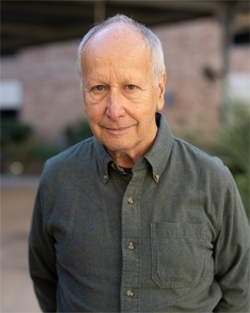
The Abel Prize 2023 has been awarded to the mathematician Luis A. Caffarelli of the University of Texas at Austin, USA, for his work on what you can think of as the mathematics of change. The Abel Prize is one of the highest accolades in mathematics. Awarded annually by the Norwegian Academy of Science and Letters, it comes with a prize money of 7.5 million Norwegian Kroner (over £575,000). Caffarelli is the 26th mathematician to receive the prize since its establishment in 2002.
Since change is pretty much the only thing that is certain in the world, the mathematics of change has a range of applications so vast, any attempt to list them would be highly incomplete. In mathematical terms, for example when it comes to finding solutions to relevant equations and figuring out if they make sense, the area throws up a deluge of open questions.
The taste of change

Luis A. Caffarelli. Photo: Nolan Zunk, University of Texas at Austin, USA
An example comes from the behaviour of fluids. These rarely sit completely still and are capable of a large range of behaviours: from blood moving smoothly through our veins to water crashing wildly down a mountain stream. Armies of people from different disciplines — engineers, meteorologists, biologists, physicists — grapple with the potentially complex behaviour of fluids every day.
In the mind of Caffarelli , a passionate cook and party host, the theory of fluid dynamics is best described in culinary terms. "Take a bottle of olive oil with no air inside, but with a bit of oregano and red pepper," he said in a talk at the Clay Mathematics Institute in 2001. "You shake the bottle really well and then sit it on the table. The fluid is moving — what you want to do is [predict] how that fluid [...] will evolve into rest."
Two things are very important when it comes to the motion of a fluid. One is its viscosity, loosely speaking its stickiness: white wine in a glass will swirl easier than the stickier olive oil in the bottle, which in turn flows better than the ketchup you're going to squeeze onto your steak. Another is pressure: if you want the ketchup to come out quicker, you squeeze the bottle harder. As long as the fluid is incompressible (it can't reduce its volume when you squeeze it), pressure causes it to accelerate.
People have known for a long time that pressure and viscosity are instrumental when it comes to describing fluid flow. But it wasn't until the 19th century that the relationship was put into mathematical terms for incompressible and viscous fluids. The Navier-Stokes equations, named after Claude-Louis Navier and Gabriel Stokes, give an exact relationship between the viscosity of a fluid, pressure, and the acceleration the fluid experiences. If you know the initial conditions of the flow (the swirling olive oil as you set it down on the table), then a solution of the equations will in theory tell you how the fluid flow will behave for all time.
The Navier-Stokes equations are examples of partial differential equations. Generally, such equations relate physical quantities (such as velocity and pressure) to the rate at which they change (such as acceleration, which is the rate of change of velocity over time). These equations involve the mathematics of calculus, which can talk about infinitesimal quantities and changes. This means you can zoom in on time and space to any desired level of accuracy.
Theory and practice
Once you've got a set of equations which you think provides a mathematical model for a physical process, there are two types of questions you can ask. One is whether you can use it to find — or at least hack your way towards — a solution to a particular problem you'd like to solve, whether it's building a car, forecasting the weather, or creating a realistic looking animation of blood splattering from a wound for a movie.
To this kind of question, for the Navier-Stokes equations, the answer is often "yes". Although exact solutions are usually impossible to come by, sophisticated methods and a lot of computing power can deliver approximate ones that are sufficiently accurate for many practical applications. They better be, given that they're used to build planes.
The other question you can ask is more general and theoretical in nature: do the equations give you a coherent theory of fluid flow? Here you're not so interested in how accurately the equations describe reality — even theories that are only roughly right can be extremely useful. Instead, you want to know if solutions to the equations always exist and whether these solutions are reasonably "nice". An example of a non-nice solution would be one which predicts that the velocity or acceleration of the fluid should become infinite at some point — although ketchup does sometimes splatter out of a bottle astonishingly fast, speeds in real life are always finite, so a prediction of infinite speed is physically meaningless.

When will the olive oil come to rest?
"This is a matter of internal coherence," Caffarelli said in his talk at the Clay Mathematics Institute. "It has nothing to do with the model reflecting reality. It has to do with the model being coherent: if you give me [initial] data, the equations at least have a nice solution, close to reality or not." Points in space and time where a solution is not nice are called singularities.
Questions about the existence and niceness of solutions can be extremely hard to answer. According to Caffarelli , when it comes to fluids, this is down to us not having a mathematical formulation that optimally covers all the bases. On the one hand, you might think of a fluid as made up of lots of little fluid particles and try to mathematically describe their behaviour. This Langrangian way of looking at things is good for describing, for example, the acceleration of a fluid. On the other hand you might decide to look at a little region of space and try and capture how the fluid moves through it. This Eulerian way of looking at things is good for describing, for example, viscosity. However, neither formulation can describe all aspects of the fluid flow equally well.
"This is the curse of fluid dynamics," Caffarelli said in his talk. "This is why equations in fluid dynamics are so difficult. You write them in one way, there is a piece that doesn't match. Write them in another way, there is another piece that doesn't match."
Milestones in fluid flows
A milestone in the theory did however come in the 1930s, when the mathematician Jean Leray showed that some sort of weak solutions exist for the Navier-Stokes equations. Here a weak solution is one where the equations are satisfied in an average sense, rather than at every point. Another thing that was figured out is that if the initial data you feed the equations — the initial velocity of the olive oil — is nice, then that niceness persists for a while, with the weak solutions not doing anything crazy in the short term.
On the other end of the spectrum, people were also able to figure out what happens in the very long term: if you let your equations evolve for a long period of time, you can be sure the solutions become nice again. This is because by that time the energy in the system has dissipated, so solutions are forced to remain small, that is, they can't be infinite. This leaves the medium term un-accounted for: could singularities appear after the effect of the nice starting conditions has disappeared and before much of the energy has dissipated?
It's regarding this question that Caffarelli, together with Robert Kohn and Louis Nirenberg, produced another milestone result in 1982. He helped to show that, if any singularities exist in this medium term, there will never be enough of them to merge together to form a continuous curve in the four-dimensional world you get when you consider space and time together. In particular, this means that singularities can only ever exist for a single point in time — if they existed for a whole interval in time, no matter how short, then this would constitute a continuous line, which Caffarelli and his colleagues showed can't exist.
"So if singularities exist, they [form] a very minimal set — they are physically sort of irrelevant because you will never see them, they will not have any effect," Caffarelli said in his talk.
Caffarelli, Kohn and Nirenberg published their result in the landmark paper Partial regularity of suitable weak solutions of the Navier-Stokes equations. The general question of whether singularities can exist at all in the solutions to the Navier-Stokes equations is still unsolved: it's the subject of a £1 million prize offered by the Clay Mathematics Institute. Out of all the mathematicians working on this problem, Caffarelli, Kohn, and Nirenberg have come closest to a solution.
Beyond fluids
Caffarelli's work on the Navier-Stoke equations is just a small part of a huge body of work on partial differential equations. For example, he also made important contributions to the so-called obstacle problem, which asks how an elastic membrane, such as a deliciously thin pancake, will settle down when you place it over an obstacle, such as a few scoops of ice cream. A related type of problem Caffarelli considered involves situations where two types of substances, such as the part of your ice cream that is still frozen solid and the part that's begun to melt, meet at an interface. Both the obstacle problem and so-called free boundary problems (which involve an interface) can be phrased in terms of partial differential equations and have applications far beyond the culinary realm.

Partial differential equations have applications way beyond the culinary realm.
"Caffarelli's theorems have radically changed our understanding of classes of nonlinear partial differential equations with wide applications," says chair of the Abel Committee Helge Holden. He describes Caffarelli's results as possessing technical virtuosity, covering many different areas of mathematics and its applications. Caffarelli's collaborator Louis Nirenberg, who himself won an Abel Prize in 2015, agrees. “Fantastic intuition, just remarkable…I had a hard time keeping up with him. He somehow immediately sees things that other people don't see," he said when asked about working with Caffarelli.
Caffarelli was born in Buenos Aires in 1948 but has spent most of his working life in the USA. He is married to the Argentinian mathematician Irene Martínez Gamba with whom, it seems, he frequently cooks up a storm for students and colleagues. "Caffarelli and his wife Irene have made this [department] like a family. They have [created] a very good environment for the younger generation of mathematicians," early career researcher Kui Ren said in an interview in 2018.
At the time of writing this article, Caffarelli does not yet know he has won the Abel Prize. When he finds out, then judging by all that we have read about him, another dinner party is sure to come up soon!
Quotes in this article come from Caffarelli's great talk at the Clay Mathematics Institute in 2001. You can watch the talk below:
About this article
Marianne Freiberger is Editor of Plus.
This article was produced as part of our collaboration with the Isaac Newton Institute for Mathematical Sciences (INI) – you can find all the content from the collaboration here.
The INI is an international research centre and our neighbour here on the University of Cambridge's maths campus. It attracts leading mathematical scientists from all over the world, and is open to all. Visit www.newton.ac.uk to find out more.
